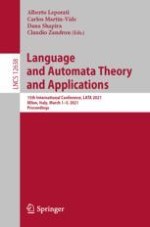2021 | Buch
Language and Automata Theory and Applications
15th International Conference, LATA 2021, Milan, Italy, March 1–5, 2021, Proceedings
herausgegeben von: Prof. Alberto Leporati, Carlos Martín-Vide, Dana Shapira, Dr. Claudio Zandron
Verlag: Springer International Publishing
Buchreihe : Lecture Notes in Computer Science
